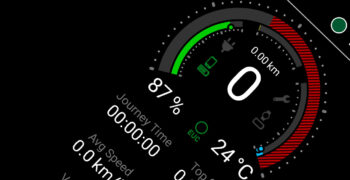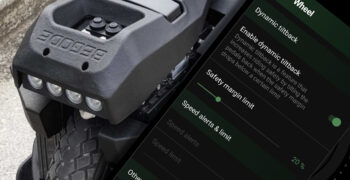History of all your wheels in one place
For most of you, EUC World is first and foremost (if not exclusively) an app that you use on your phone. It takes care of your safety, presents you with key wheel parameters or makes riding more fun thanks to the AVAS function. But in addition to the app, the EUC World website also offers interesting features that complement what you already have in the app. Today, I would like to introduce you to one of the recently added features, which is the history of your wheels. Although this may not seem especially interesting to you at first, let me introduce you to this feature in more detail. I am sure that after reading this article you will find a lot of use cases for this feature. You will find it in your user account after logging in to the EUC World website or just by clicking here to open history of all your wheels now.
Before we begin
Before I take you through the details, here are a few tips to help you view your wheels history. In addition to textual information, it contains graphs of the history of selected wheel parameters. The graphs will be most readable if you use a computer or tablet to view the list. However, if you are using a smartphone, it is a good idea to view the wheels history in landscape mode. As the charts can be zoomed and panned using touch gestures, to scroll through the list you need to touch the screen outside the chart area. When using a mouse, to zoom in on the chart use the mouse wheel while holding down the Shift key. When more parameters are presented on the chart, their display can be switched on and off by clicking on their name in the legend above the chart.
I would like to inform those of you who have been using EUC World for many years, that the information presented in the wheels history may not be complete. The history of wheels and the information presented here is the result of the compilation of a variety of data that began to be collected at various points in the development of EUC World.
Now that the most important things have been clarified, we can move on to discuss the individual parts of information you may see in the history. For most of you, the list will contain one or two items, but owners of more wheels or users that tends to switch wheels qiote often will find more wheels. In this case, I suggest that you change the default sorting of the list so that the list is sorted by last seen date in descending order. This way, the most recently used wheel will be the first on the list. In the header you will find the Bluetooth name of the wheel, the model name and when this wheel was last seen by the EUC World application. If you click on the header, detailed information will unfold, divided into individual sections (that also unfolds when clicked). Depending on the wheel model and the amount of time you have used the wheel with the EUC World app, there will be more or less data.
General info & mileage
In the first section you will find general information that allows you to identify the wheel. You will find out the first seen date – a date on which the wheel was first connected to the EUC World application – and the last seen date. This information is useful for assessing how long a wheel has been or still is in your possession. In this section you can also find information such as the serial number, the last used speed and distance corrections or the wheel’s firmware version. If there has been a firmware update between the first and last connection of the wheel, you will also find this information in this wheel information section.
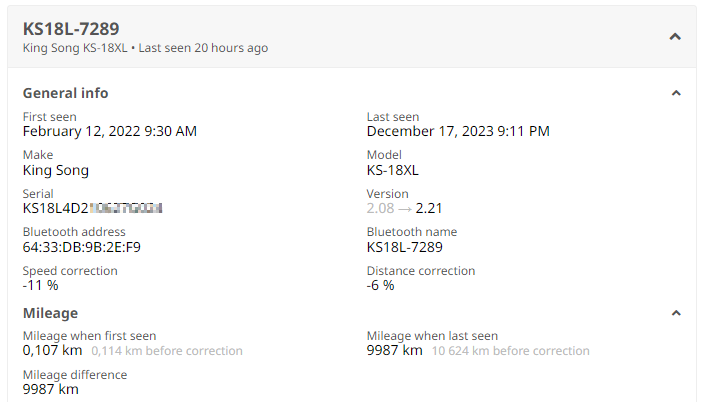
Important information!
As I already mentioned, in the wheels history you will find all the wheels with which your EUC World application has connected. It’s likely that not only will these be your wheels, but you may also find a colleague’s wheel or even a wheel belonging to someone who has participated in the same group ride. For this reason, wheel serial numbers will only be shown for wheels on which you have ridden a total of at least six hours.
The next section presents information on the wheel’s mileage. Here you can easily get an idea of the total distance travelled on the wheel. If you have set corrections to the distance in the app, you will see both the mileage without correction (usually inflated by few percent) and the more accurate mileage after the correction was applied. If EUC World detects that at any time in the known history this wheel has had a higher mileage than the last time it was connected, this information will also be displayed here. This may indicate attempts to tamper with the wheel, but could also be just the result of rounding errors or Bluetooth transmission errors, unfortunately quite common in Gotway/Begode and some Veteran wheels.
Battery & battery history
The next very important section is the battery information. Depending on the wheel model, the extent of the information will vary. In some cases, this section may not be visible at all. In most cases you will only find information about the battery circuit resistance. However, if the wheel is equipped with a smart BMS, you can find more information such as the serial numbers of the battery modules, their firmware versions or the health and imbalance of each module. This information, which in general indicates the condition of the battery, can be useful for early detection of battery problems.
You will see a history of changes to key battery parameters in the battery history chart. As above, you will find more or less data here depending on the wheel model. The battery history graph may not be available if there is insufficient data collected when using the wheel.
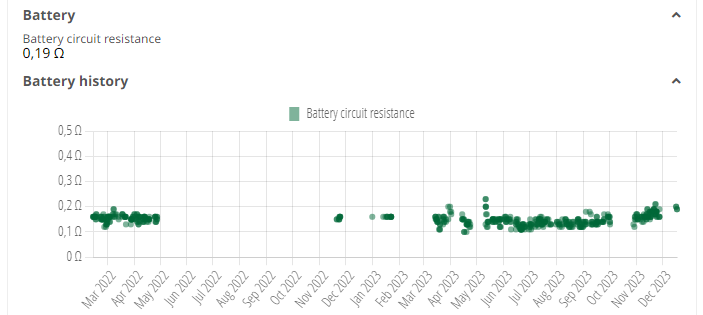
Here I would like to bring your attention to the battery circuit resistance history graph. This parameter is dynamically determined by the EUC World application as you ride. The higher this value is, the voltage sag will also be higher during acceleration and braking. It can be assumed that a battery circuit resistance of no more than 0.3 Ω is a valid value, and values above 0.4 Ω should be considered as a sign of a battery circuit problem. It may be faulty battery connector, it may be wiring problem or it may be worn or damaged battery. However, do not worry if you observe isolated values above the accepted norm on the graph. As long as the most of values are clustered below 0.3 Ω, the occasional higher values can be discarded as a measurement errors. As a rule, battery wear is accompanied by a slow increase in battery circuit resistance. However, it should be kept in mind that changes in resistance are significantly affected by the temperature of the cells (for example, battery resistance will be higher in cold, winter days). Therefore, when seeing seasonal changes in the curve on the graph, do not immediately assume that the battery is worn out. Only a noticeable upward trend in battery circuit resistance over the course of a year or two will be an indication of a decline in battery life and capacity.
For wheels equipped with a smart BMS, a history of battery imbalance may also be presented. The imbalance, expressed in volts, should be as low as possible. Optimally, the imbalance should not exceed 0.1 V. Larger unbalance may indicate a problem with the battery condition, wear and tear or even be a sign of a faulty cells. A battery with a high imbalance is a potential fire and explosion hazard. If you notice that the imbalance of the battery significantly exceeds 0.1 V, do not charge such a battery and do not use the wheel, but contact service or your dealer immediately.
Oh, and remember that the battery information and battery history graph will not be available for most Gotway/Begode and Veteran wheels.
Rides & tours
Let me start by explaining what the term “ride” means here. You may already be familiar with the term “tour”, but it would be good to remind that a “tour” is a detailed record of your ride, recorded using the tour recording feature of the EUC World app. With the tour recording, you can record all the details of your ride, display it and share on a live map, just as you ride or at any time later. More, you can add photos and videos of places of interest visited during your ride. Tour recording not only records the locations along the route of the ride with two-second resolution, but also key wheel parameters like speed, power, safety margin, temperatures etc. By default, tours are not recorded when you ride with EUC World, although it is possible to set the EUC World app to automatically start tour recording when it connects to the wheel.
Rides, on the other hand, are recorded every time EUC World connects with the wheel, without any user intervention. They contain general information about each ride, but unlike tours, data along the route of the ride such as the path or detailed wheel parameters are not recorded. It is worth remembering that every recorded tour is also accompanied by a recorded ride. Therefore, when reviewing rides and tours history, it is worth keeping in mind that these data may look similar. This will be particularly noticeable in the history graphs.
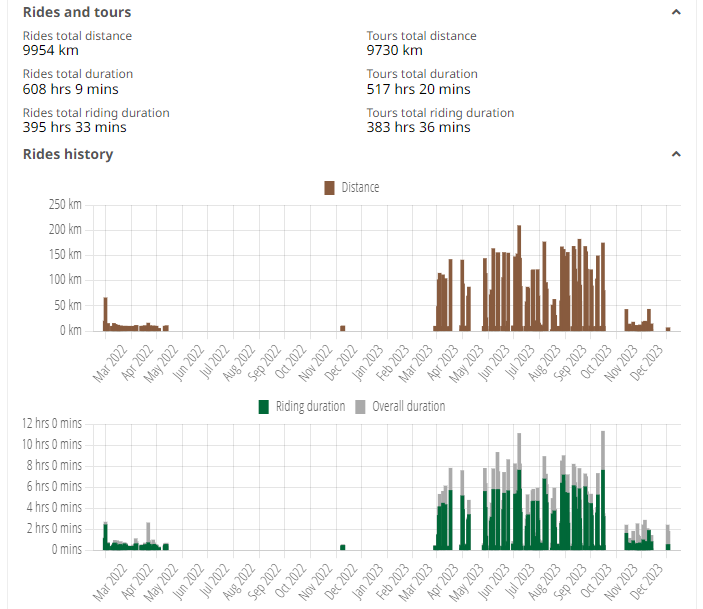
In this section, you will find information on the total distance ridden by you on a given wheel, the total duration of all rides and tours and also total riding time (time in motion, in other words). Remember that the ride duration is actually the time the application stays connected to the wheel. Therefore, do not be surprised if you’ll find rides total duration very high. The most reliable indicator of your riding intensity will therefore be the total riding duration.
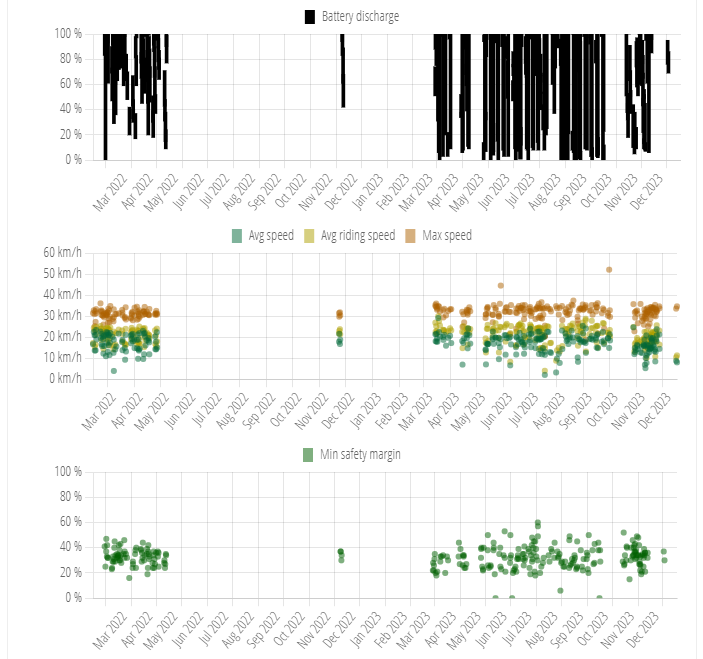
Your rides and tours history graphs will provide you with the most interesting information. In most cases, your rides history will contain more information than your tours history. Most of the graphs need no explanation, like distance or duration. I would just like to draw your attention to the battery discharge graph. Each bar shows how much the battery has been discharged during a ride or tour. In this graph, you can also see whether you tend to drain the battery deeply or whether you prefer to recharge the battery as often as possible. It is worth mentioning, however, that the graph does not show information about charging that took place during a ride or tour. So if we started a ride with a fully charged battery, discharged it almost completely, then charged it to full and finished the ride with an 80% charge, we will only find a short bar ranging from 100% to 80%.
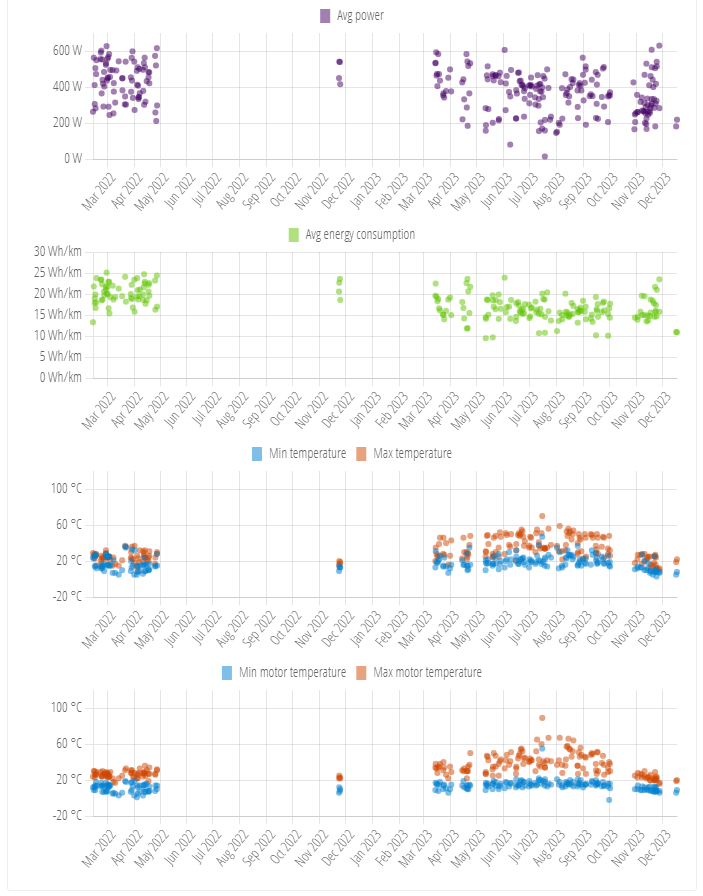
Finally, I would also like to remind you that the data presented in the wheels history may contain inaccuracies or errors. This is most often due to errors during Bluetooth data transmission, which are not uncommon with Gotway/Begode wheels and older models of Veteran wheels. The data may also be incomplete or there may be no data at all. In this case it’s usuallu caused by a lack of Internet connection on the device on which you are using EUC World. Another possible cause is a disabled GPS or location. A permanent Internet connection is not necessary as long as your device can connect to the Internet using WiFi at home or at work.
Final note – compilation of the wheels history requires the processing of a large amount of data. Also developing of this feature required a great amount of time and work. Therefore, the wheels history is available exclusively to Premium Users who support the maintenance and further development of the EUC World project.
